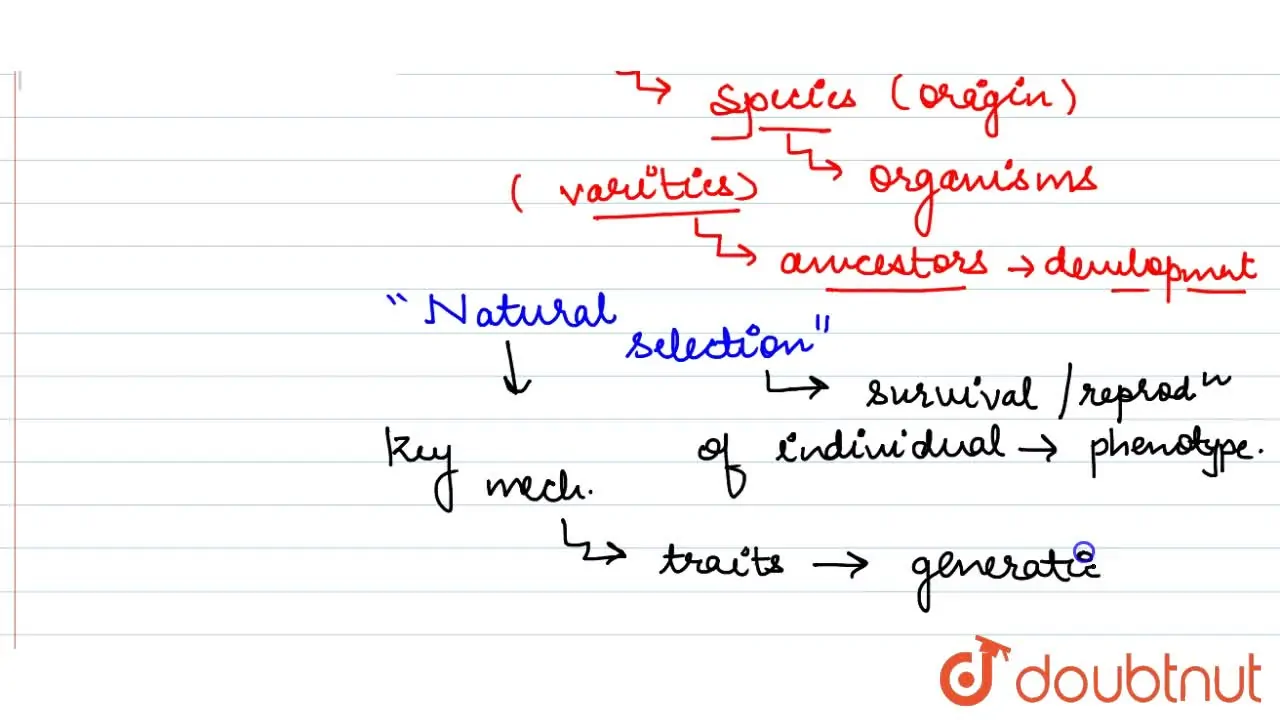Describe the Darwin's theory of natural selection
1. Darwin's theory of Natural selection : Darwin's theory of Natural selection is based on the following principles :
(1) Over production or enormous fertility or prodigality of production : Every living organism has a great potentiality of reproduction. Therefore, they produce many young ones but only few can survive up to maturity. Any population tends to increase in geometrical proportion causing over production of its members.
(2) Struggle for existence: Organisms multiply in geometric ratio but the space and food remain constant leading to competition for survival. This competition is called struggle for existence. The struggle may be intraspecific, intersp'ecific or environmental.
(3) Variations and heredity: Variations are the differences between individuals of the same species. Variations may be harmful. i.e. unfavourable, neutral or useful i.e. favourable. The useful variations are preserved and passed on to their offsprings.
(4) Survival of the fittest or Natural selection : The organisms having useful and favourable variations succeed in the struggle for existence. These organisms are the fittest for survival. While the organisms with unfavourable variations are unfit to survive and thus nature does not select them. This is called survival of the fittest. Since the nature selects the organisms which are provided with favourable variations hence the theory is known as the theory of Natural selection.
(5) Origin of new species : A new species originates by the gradual accumulation of favourable variations for a number of generations. Nature selects organisms with favourable variations which have better chance for survival. Due to gradual chap.ges in the organisms after many generations the descendants appear to be different from their ancestors and are identified as new species.
Related Playlists
- BOOK - NAVNEET PUBLICATION - MAHARASHTRA BOARDCHAPTER - SHORT ANSWER QUESTIONS -IIEXERCISE - Ch-11 (Chromosomal Basis of Inheritance)18videos
SHORT ANSWER QUESTIONS -II
- BOOK - NAVNEET PUBLICATION - MAHARASHTRA BOARDCHAPTER - SHORT ANSWER QUESTIONS -IIEXERCISE - Ch-15 (Circulation)4videos
SHORT ANSWER QUESTIONS -II
- BOOK - NAVNEET PUBLICATION - MAHARASHTRA BOARDCHAPTER - SHORT ANSWER QUESTIONS -IIEXERCISE - Ch-9 (Organisms and Environment-I)5videos
SHORT ANSWER QUESTIONS -II
- BOOK - NAVNEET PUBLICATION - MAHARASHTRA BOARDCHAPTER - SHORT ANSWER QUESTIONS -I EXERCISE - Chapter 19 : Organisms and Environment - II7videos
SHORT ANSWER QUESTIONS -I
- BOOK - NAVNEET PUBLICATION - MAHARASHTRA BOARDCHAPTER - SHORT NOTES EXERCISE - Short notes on2videos
SHORT NOTES
Similar Questions
(a) "Ontogeny repeats phylogeny". Justify.
(b) Describe Charles Darwin's theory of natural selection.View SolutionDescribe the Darwin's theory of natural selection
View SolutionNote down the differences between Darwin's theory of natural selection and Lamarckism.
View SolutionWhat are the main points of theory of mutations proposed by Hugo de Vries or Darwin's theory of natural selection.
View SolutionDescribe the charles Darwin's theory of natural selection .
View SolutionWhich of the following is not under Darwin's theory of natural selection ?
View SolutionWrite a short not on Darwin's theory of natural selection.
View SolutionEnlist the objections raised against Darwin's theory of natural selection?
View SolutionDefine 'evolution'. Give the principles of Darwin's theory of natural selection. Mention any 'one' objection to it.
View SolutionThe main drawback of Darwin's theory of natural selection was that it could not provide satisfactory explanation of
View Solution


